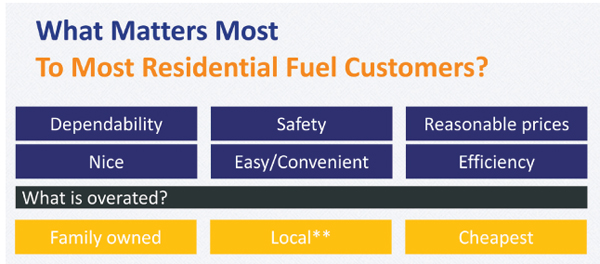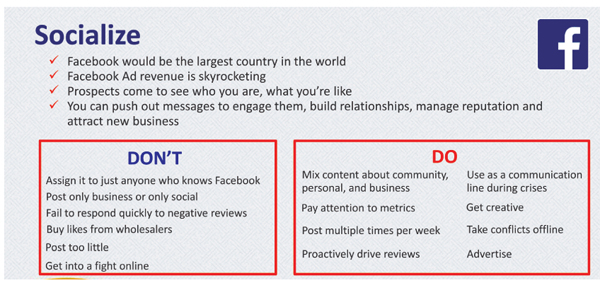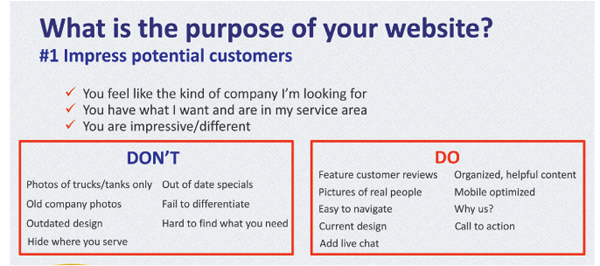Monday, November 30, 2020
For the past several years, the “new normal” in marketing has centered around digital communications and new opportunities presented by technology, especially with the dawn of smartphone use, to communicate with customers.
 In the year 2020, the availability of digital marketing brought a lot of new adopters as COVID-19 became a threat to people around the world.
In the year 2020, the availability of digital marketing brought a lot of new adopters as COVID-19 became a threat to people around the world.
“Suddenly, my father, who was used to ordering food by phone to pick up, was using DoorDash to order and pay for food with contactless delivery,” said Gary Corbett of Warm Thoughts Communications. Corbett presented a webinar titled “Marketing in the New Normal” during the Virtual Propane Expo in late June. “For those who were behind in technology usage, the pandemic presented real benefits to getting caught up fast.”
BOOSTING DIGITAL USE
“With the COVID-19 pandemic, there are many ways providers of home services are seeing new habits in customers and many ways technology can help meet the need,” Corbett told BPN. “Many people want contactless service and the ability to pay bills online. The companies who can best meet these needs will gain new customers. The social-distancing lifestyle is presenting new opportunities.” Corbett’s presentation noted that internet usage has spiked during the coronavirus outbreak. “Social media, texting, video chatting via Zoom, Facebook, and Houseparty have become people’s connection to the world outside their homes.”
Key changes due to the pandemic include a return to price awareness, lost jobs, reduced wages, fuel prices at record lows, and competitors hunting for new accounts. Corbett noted that people are focused on home time more than ever. “Vacations are becoming staycations,” he said. “E-commerce spending is up 30% over last year. Sales are up 220% in the furniture category amongst online sellers. The New York Times has eliminated their highly influential Travel section and replaced it with a new section called At Home.”
“Even now that things are trending toward ‘normal,’ spending time at home will be part of the new normal,” Corbett said. “During the recovery from the 2008 recession, we saw an increase in expenditures on ‘home comfort’ as people opted to focus on their homes, updating inefficient equipment and improving their comfort. For most people, spending more time at home means a desire to have your home more comfortable and more efficient.”
He noted that this year, in the month of March, Rinnai sold a record number of tankless water heaters as homeowners faced the reality of increased hot water demand while everyone in the family is home. Other observations included a 14% increase in organic traffic searches to oil, propane, and HVAC companies’ websites; an 18% increase in visits to their websites generated by paid search campaigns; a 10% increase in total leads; and a 50% increase in Facebook usage.
 “We have an opportunity now where customers are looking to pay bills online, enroll in payment programs like budget plans and automatic payments, review social distancing policies, and shop for equipment such as water heaters,” Corbett explained. “Prospects are looking to see if they can do better than their current provider and looking for new customer offers.”
“We have an opportunity now where customers are looking to pay bills online, enroll in payment programs like budget plans and automatic payments, review social distancing policies, and shop for equipment such as water heaters,” Corbett explained. “Prospects are looking to see if they can do better than their current provider and looking for new customer offers.”
MARKETERS’ WEBSITE MISTAKES
As a carefully designed presence on the internet becomes more and more important, BPN asked Corbett to identify the biggest mistake he sees in propane websites. “Most overlook the importance of having the website be found in the first place,” Corbett said. “If you can’t be easily found, it doesn’t matter how good the website is. Knowing how search engine optimization and algorithms work is important. It is good to have a dedicated employee or outsource who understands these concepts and how to update properly and utilize key words. Once on the website, it is important to be able to find the key information you are looking for. Prospective customers are looking for an opportunity to become a customer. They don’t want to search too hard for the key information they are looking for. If not easily found, they may move on.”
Corbett noted that while Yellow Pages used to be the top method for finding a service provider, the internet has changed the game completely. “Some young adults have never used the Yellow Pages. They went straight to learning to use Google searches. Most adults of all ages are now doing internet searches, so companies need to be very savvy about key words and the towns served being prominent on the webpages.”
 BPN asked Corbett if Facebook is the main social media platform retail energy providers should be using for marketing. “Facebook is the platform that should be used first and foremost,” Corbett said. “Most don’t have the staff to keep up with much more than Facebook. It is better to have a consistently updated presence on one platform rather than a weak presence on three.” He mentioned Instagram and Twitter as the next most popular platforms where an energy marketer may want to be.
BPN asked Corbett if Facebook is the main social media platform retail energy providers should be using for marketing. “Facebook is the platform that should be used first and foremost,” Corbett said. “Most don’t have the staff to keep up with much more than Facebook. It is better to have a consistently updated presence on one platform rather than a weak presence on three.” He mentioned Instagram and Twitter as the next most popular platforms where an energy marketer may want to be.
“Facebook plus Google equals a lot of search engine optimization. If you are not showing up in searches for your services or for water heaters, etc., you are not going to get optimum attention. You must be found by the categories of services you offer in every town in your service territory.”
PURPOSE OF THE WEBSITE
“Impressing potential customers should be the No. 1 purpose of your website,” Corbett said. “The prospect should feel you have the kind of company they seek, the prospect should feel you have what they want and are in their service area, and they should feel you are impressive and different.” Don’ts include photos of trucks/tanks only, old company photos, outdated design, hiding where you serve, out-of-date specials, failure to differentiate, and making it hard to find what is needed. Do’s include featuring customer reviews, pictures of real people, making navigation easy, a current design, addition of live chat, content that is organized and helpful, mobile optimization, an answer to the question “Why us?,” and a call to action.
Corbett noted that factors most customers look for include dependability, safety, reasonable prices, niceness, easiness/convenience, and efficiency. Overrated features are family owned, local, and cheapest.
“Can customers interact with the website?” Corbett asked. “Can customers pay on the site? Is there a virtual showroom for hearth products, grills, water heaters, etc.? Are you focused on turning passive website visits into action?” He said that inviting calls, form submits, and chats are key tools for mobilizing new customers.
Another key point Corbett made was the importance of site performance in a mobile environment. He pointed out that websites used to be designed first and foremost for desktop and laptop computer screens. “Later it was stressed that websites should also be ‘mobile-friendly,’ meaning the site should be adjustable to a mobile device,” Corbett explained. “Now, most web searches are being done from a mobile device and the advice is ‘mobile-first,’ meaning sites should be designed first and foremost for the mobile screen and adjustable to the desktop or laptop screen. Ninety percent of people will move on from your site if the mobile experience is bad; 88% of people won’t come back after a bad experience.” — Pat Thornton
 In the year 2020, the availability of digital marketing brought a lot of new adopters as COVID-19 became a threat to people around the world.
In the year 2020, the availability of digital marketing brought a lot of new adopters as COVID-19 became a threat to people around the world.“Suddenly, my father, who was used to ordering food by phone to pick up, was using DoorDash to order and pay for food with contactless delivery,” said Gary Corbett of Warm Thoughts Communications. Corbett presented a webinar titled “Marketing in the New Normal” during the Virtual Propane Expo in late June. “For those who were behind in technology usage, the pandemic presented real benefits to getting caught up fast.”
BOOSTING DIGITAL USE
“With the COVID-19 pandemic, there are many ways providers of home services are seeing new habits in customers and many ways technology can help meet the need,” Corbett told BPN. “Many people want contactless service and the ability to pay bills online. The companies who can best meet these needs will gain new customers. The social-distancing lifestyle is presenting new opportunities.” Corbett’s presentation noted that internet usage has spiked during the coronavirus outbreak. “Social media, texting, video chatting via Zoom, Facebook, and Houseparty have become people’s connection to the world outside their homes.”
Key changes due to the pandemic include a return to price awareness, lost jobs, reduced wages, fuel prices at record lows, and competitors hunting for new accounts. Corbett noted that people are focused on home time more than ever. “Vacations are becoming staycations,” he said. “E-commerce spending is up 30% over last year. Sales are up 220% in the furniture category amongst online sellers. The New York Times has eliminated their highly influential Travel section and replaced it with a new section called At Home.”
“Even now that things are trending toward ‘normal,’ spending time at home will be part of the new normal,” Corbett said. “During the recovery from the 2008 recession, we saw an increase in expenditures on ‘home comfort’ as people opted to focus on their homes, updating inefficient equipment and improving their comfort. For most people, spending more time at home means a desire to have your home more comfortable and more efficient.”
He noted that this year, in the month of March, Rinnai sold a record number of tankless water heaters as homeowners faced the reality of increased hot water demand while everyone in the family is home. Other observations included a 14% increase in organic traffic searches to oil, propane, and HVAC companies’ websites; an 18% increase in visits to their websites generated by paid search campaigns; a 10% increase in total leads; and a 50% increase in Facebook usage.
 “We have an opportunity now where customers are looking to pay bills online, enroll in payment programs like budget plans and automatic payments, review social distancing policies, and shop for equipment such as water heaters,” Corbett explained. “Prospects are looking to see if they can do better than their current provider and looking for new customer offers.”
“We have an opportunity now where customers are looking to pay bills online, enroll in payment programs like budget plans and automatic payments, review social distancing policies, and shop for equipment such as water heaters,” Corbett explained. “Prospects are looking to see if they can do better than their current provider and looking for new customer offers.”MARKETERS’ WEBSITE MISTAKES
As a carefully designed presence on the internet becomes more and more important, BPN asked Corbett to identify the biggest mistake he sees in propane websites. “Most overlook the importance of having the website be found in the first place,” Corbett said. “If you can’t be easily found, it doesn’t matter how good the website is. Knowing how search engine optimization and algorithms work is important. It is good to have a dedicated employee or outsource who understands these concepts and how to update properly and utilize key words. Once on the website, it is important to be able to find the key information you are looking for. Prospective customers are looking for an opportunity to become a customer. They don’t want to search too hard for the key information they are looking for. If not easily found, they may move on.”
Corbett noted that while Yellow Pages used to be the top method for finding a service provider, the internet has changed the game completely. “Some young adults have never used the Yellow Pages. They went straight to learning to use Google searches. Most adults of all ages are now doing internet searches, so companies need to be very savvy about key words and the towns served being prominent on the webpages.”
 BPN asked Corbett if Facebook is the main social media platform retail energy providers should be using for marketing. “Facebook is the platform that should be used first and foremost,” Corbett said. “Most don’t have the staff to keep up with much more than Facebook. It is better to have a consistently updated presence on one platform rather than a weak presence on three.” He mentioned Instagram and Twitter as the next most popular platforms where an energy marketer may want to be.
BPN asked Corbett if Facebook is the main social media platform retail energy providers should be using for marketing. “Facebook is the platform that should be used first and foremost,” Corbett said. “Most don’t have the staff to keep up with much more than Facebook. It is better to have a consistently updated presence on one platform rather than a weak presence on three.” He mentioned Instagram and Twitter as the next most popular platforms where an energy marketer may want to be.“Facebook plus Google equals a lot of search engine optimization. If you are not showing up in searches for your services or for water heaters, etc., you are not going to get optimum attention. You must be found by the categories of services you offer in every town in your service territory.”
PURPOSE OF THE WEBSITE
“Impressing potential customers should be the No. 1 purpose of your website,” Corbett said. “The prospect should feel you have the kind of company they seek, the prospect should feel you have what they want and are in their service area, and they should feel you are impressive and different.” Don’ts include photos of trucks/tanks only, old company photos, outdated design, hiding where you serve, out-of-date specials, failure to differentiate, and making it hard to find what is needed. Do’s include featuring customer reviews, pictures of real people, making navigation easy, a current design, addition of live chat, content that is organized and helpful, mobile optimization, an answer to the question “Why us?,” and a call to action.
Corbett noted that factors most customers look for include dependability, safety, reasonable prices, niceness, easiness/convenience, and efficiency. Overrated features are family owned, local, and cheapest.
“Can customers interact with the website?” Corbett asked. “Can customers pay on the site? Is there a virtual showroom for hearth products, grills, water heaters, etc.? Are you focused on turning passive website visits into action?” He said that inviting calls, form submits, and chats are key tools for mobilizing new customers.
Another key point Corbett made was the importance of site performance in a mobile environment. He pointed out that websites used to be designed first and foremost for desktop and laptop computer screens. “Later it was stressed that websites should also be ‘mobile-friendly,’ meaning the site should be adjustable to a mobile device,” Corbett explained. “Now, most web searches are being done from a mobile device and the advice is ‘mobile-first,’ meaning sites should be designed first and foremost for the mobile screen and adjustable to the desktop or laptop screen. Ninety percent of people will move on from your site if the mobile experience is bad; 88% of people won’t come back after a bad experience.” — Pat Thornton


